SET721 - Sustainable Engineering: Current Trends, Practices, Solutions
VerifiedAdded on 2023/06/04
|11
|2713
|83
Report
AI Summary
This research paper reviews current trends and solutions in sustainable engineering, focusing on food production, renewable technologies, manufacturing processes, mineral extraction, and infrastructure. It emphasizes the importance of social, economic, and environmental sustainability. The paper discusses sustainable manufacturing practices like design for the environment and life cycle analysis, as well as improvements through reduction, reuse, and recycling. In food production, it highlights efficient land usage, soil nutrient improvement, and oceanic management. For mineral extraction, the report stresses social responsibility, safe working conditions, and minimizing environmental impacts. Regarding infrastructure, it suggests improving life cycle performance, using recycled materials, and exploring alternative construction materials. Finally, the paper explores renewable technologies like marine energy and solar photovoltaics, advocating for the integration of passive solar designs and locally available materials. This assignment solution is available on Desklib, where students can find a wide array of academic resources.
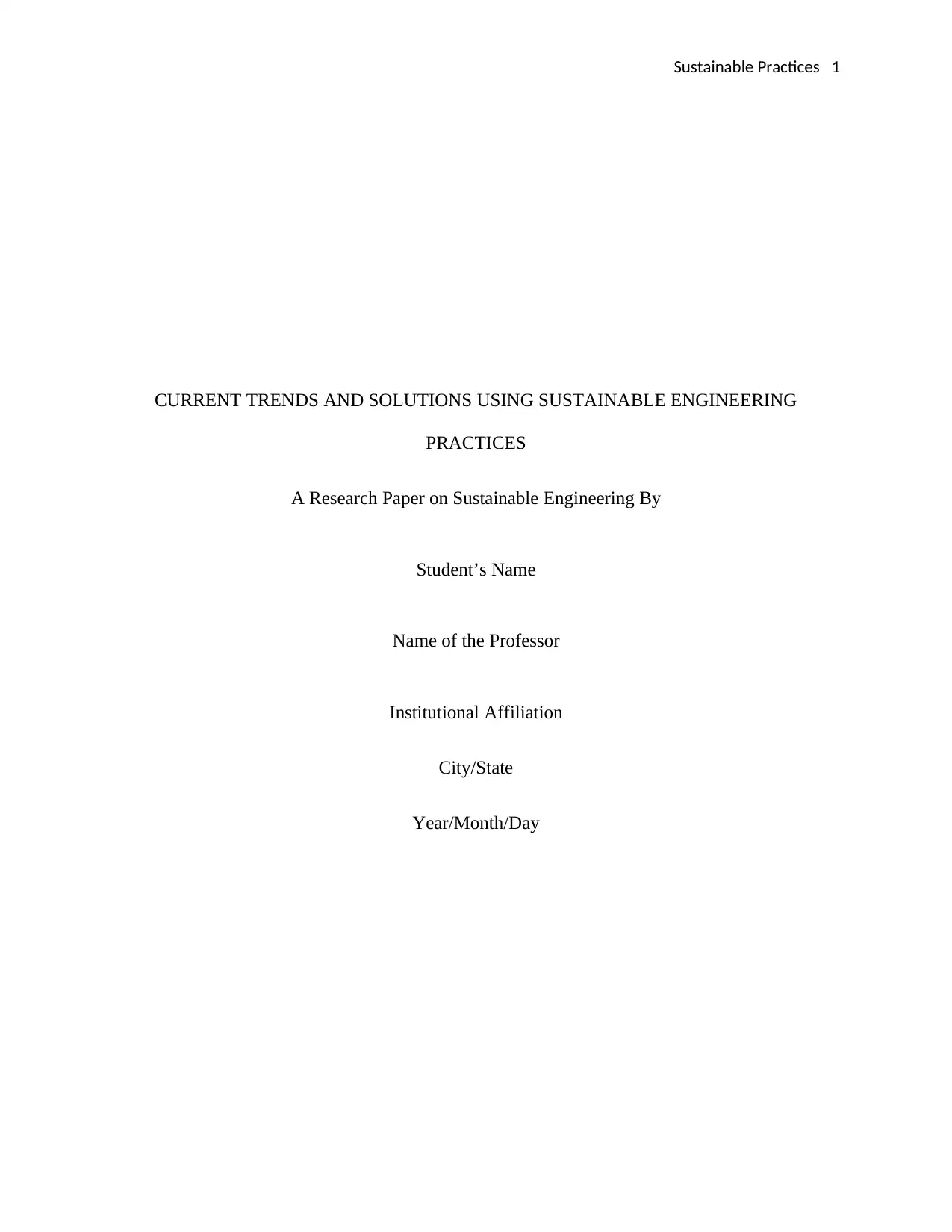
Sustainable Practices 1
CURRENT TRENDS AND SOLUTIONS USING SUSTAINABLE ENGINEERING
PRACTICES
A Research Paper on Sustainable Engineering By
Student’s Name
Name of the Professor
Institutional Affiliation
City/State
Year/Month/Day
CURRENT TRENDS AND SOLUTIONS USING SUSTAINABLE ENGINEERING
PRACTICES
A Research Paper on Sustainable Engineering By
Student’s Name
Name of the Professor
Institutional Affiliation
City/State
Year/Month/Day
Paraphrase This Document
Need a fresh take? Get an instant paraphrase of this document with our AI Paraphraser

Sustainable Practices 2
EXECUTIVE SUMMARY
The sustainability concept aims at making critical decisions concerning the long-term
performance of critical resources so as to preserve these resources to the future generation. The
major sustainability factors that have been critically analyzed in this assessment paper include
the social sustainability, economic sustainability, and environmental sustainability. The progress,
profitability, and productivity of the manufacturing companies are progressively being
considered as the strategic approaches in the process of manufacturing. Some of the current
emerging renewable energy technologies that can be implemented to promote the energy
sustainability include marine energy, concentrated solar photovoltaics, enhanced geothermal
energy system, cellulosic ethanol and artificial photosynthesis. The construction incentives
provided by the governments should focus on reducing the number of materials used in the
construction which will automatically reduce the cost of construction and preserve the
environment.
EXECUTIVE SUMMARY
The sustainability concept aims at making critical decisions concerning the long-term
performance of critical resources so as to preserve these resources to the future generation. The
major sustainability factors that have been critically analyzed in this assessment paper include
the social sustainability, economic sustainability, and environmental sustainability. The progress,
profitability, and productivity of the manufacturing companies are progressively being
considered as the strategic approaches in the process of manufacturing. Some of the current
emerging renewable energy technologies that can be implemented to promote the energy
sustainability include marine energy, concentrated solar photovoltaics, enhanced geothermal
energy system, cellulosic ethanol and artificial photosynthesis. The construction incentives
provided by the governments should focus on reducing the number of materials used in the
construction which will automatically reduce the cost of construction and preserve the
environment.
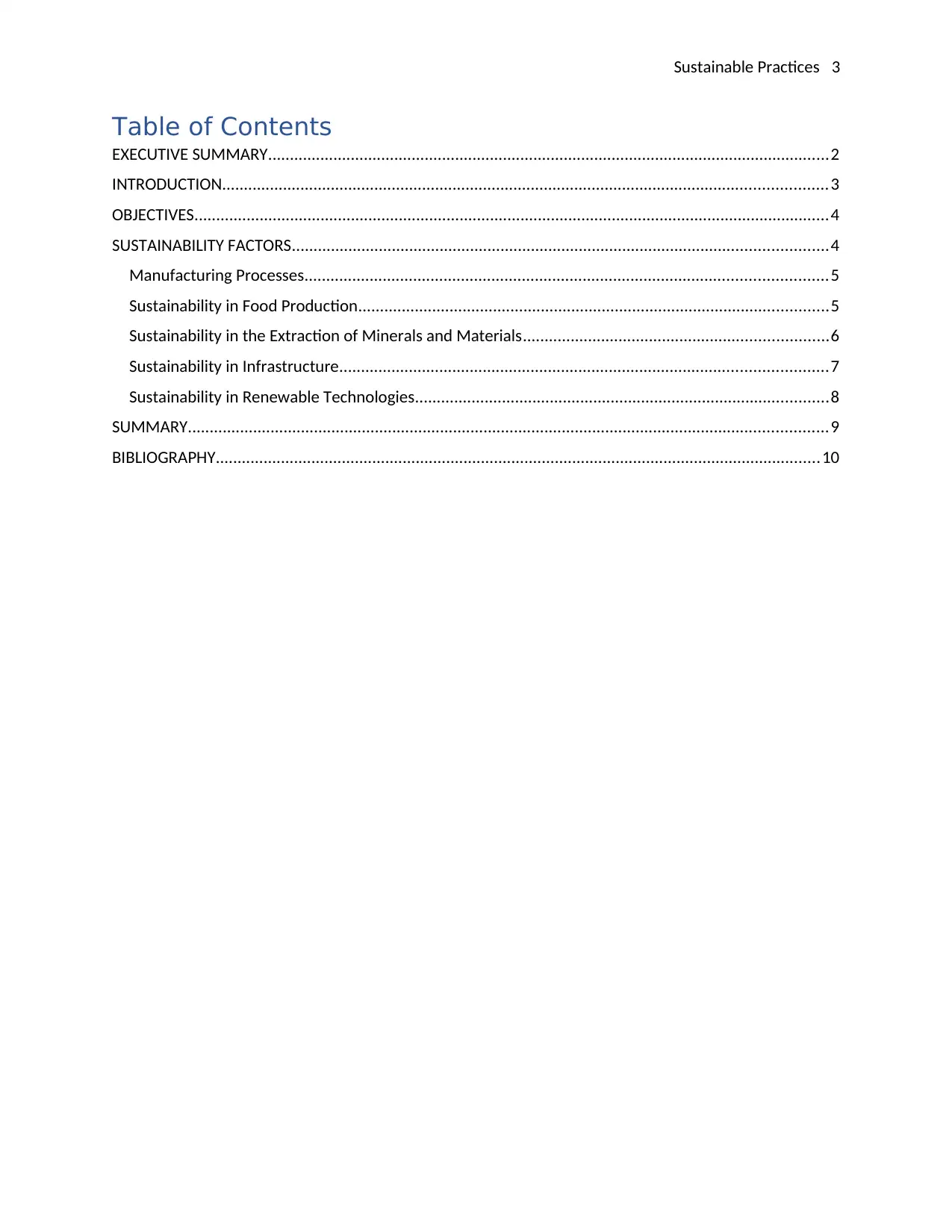
Sustainable Practices 3
Table of Contents
EXECUTIVE SUMMARY.................................................................................................................................2
INTRODUCTION...........................................................................................................................................3
OBJECTIVES..................................................................................................................................................4
SUSTAINABILITY FACTORS...........................................................................................................................4
Manufacturing Processes........................................................................................................................5
Sustainability in Food Production............................................................................................................5
Sustainability in the Extraction of Minerals and Materials......................................................................6
Sustainability in Infrastructure................................................................................................................7
Sustainability in Renewable Technologies...............................................................................................8
SUMMARY...................................................................................................................................................9
BIBLIOGRAPHY...........................................................................................................................................10
Table of Contents
EXECUTIVE SUMMARY.................................................................................................................................2
INTRODUCTION...........................................................................................................................................3
OBJECTIVES..................................................................................................................................................4
SUSTAINABILITY FACTORS...........................................................................................................................4
Manufacturing Processes........................................................................................................................5
Sustainability in Food Production............................................................................................................5
Sustainability in the Extraction of Minerals and Materials......................................................................6
Sustainability in Infrastructure................................................................................................................7
Sustainability in Renewable Technologies...............................................................................................8
SUMMARY...................................................................................................................................................9
BIBLIOGRAPHY...........................................................................................................................................10
⊘ This is a preview!⊘
Do you want full access?
Subscribe today to unlock all pages.

Trusted by 1+ million students worldwide

Sustainable Practices 4
INTRODUCTION
This research paper on sustainable engineering reviews the current trends and solutions
relating to the sustainable practices and engineering by majorly considering food production,
renewable technologies, new manufacturing processes, and extraction of minerals or materials,
and infrastructure challenges. The concept of sustainability aims at making critical decisions
concerning the long-term performance of critical resources so as to preserve these resources to
the future generation. Sustainable engineering practices can be defined as the process of
designing and operating systems in a way that they use energy resources sustainably to prevent
the depletion of these resources to the future generation.
The concept of sustainability is currently becoming very significant in all the engineering
practices making the sustainability of resources to be the major aim of human development. The
major factors of sustainability critically analyzed in this assessment paper include the social
sustainability, economic sustainability, and environmental sustainability. The social
sustainability entails the social equity, labour rights, social justice, cultural competence, and
community development. The economic sustainability entails manufacturing processes,
infrastructure, food production, extraction of materials and minerals and renewable technologies.
OBJECTIVES
The major objectives of this assessment paper include:
To critically analyze the sustainable engineering practices
To evaluate factors affecting the sustainability of resources
To analyze the effects of sustainability on the future generation
To speculate over the current practices implemented to promote sustianabili8ty
To evaluate how sustainability practices will attain the future needs of the future
generation
INTRODUCTION
This research paper on sustainable engineering reviews the current trends and solutions
relating to the sustainable practices and engineering by majorly considering food production,
renewable technologies, new manufacturing processes, and extraction of minerals or materials,
and infrastructure challenges. The concept of sustainability aims at making critical decisions
concerning the long-term performance of critical resources so as to preserve these resources to
the future generation. Sustainable engineering practices can be defined as the process of
designing and operating systems in a way that they use energy resources sustainably to prevent
the depletion of these resources to the future generation.
The concept of sustainability is currently becoming very significant in all the engineering
practices making the sustainability of resources to be the major aim of human development. The
major factors of sustainability critically analyzed in this assessment paper include the social
sustainability, economic sustainability, and environmental sustainability. The social
sustainability entails the social equity, labour rights, social justice, cultural competence, and
community development. The economic sustainability entails manufacturing processes,
infrastructure, food production, extraction of materials and minerals and renewable technologies.
OBJECTIVES
The major objectives of this assessment paper include:
To critically analyze the sustainable engineering practices
To evaluate factors affecting the sustainability of resources
To analyze the effects of sustainability on the future generation
To speculate over the current practices implemented to promote sustianabili8ty
To evaluate how sustainability practices will attain the future needs of the future
generation
Paraphrase This Document
Need a fresh take? Get an instant paraphrase of this document with our AI Paraphraser
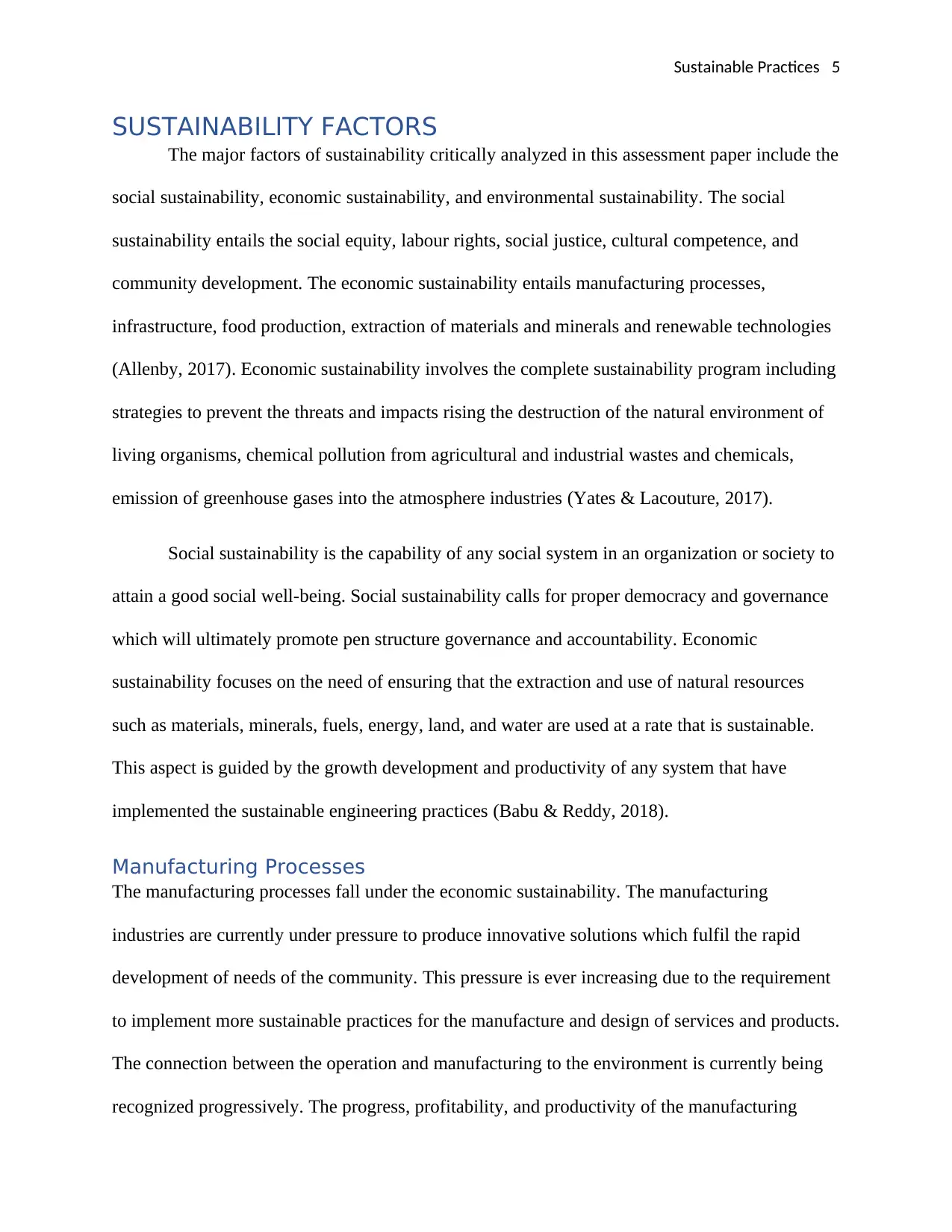
Sustainable Practices 5
SUSTAINABILITY FACTORS
The major factors of sustainability critically analyzed in this assessment paper include the
social sustainability, economic sustainability, and environmental sustainability. The social
sustainability entails the social equity, labour rights, social justice, cultural competence, and
community development. The economic sustainability entails manufacturing processes,
infrastructure, food production, extraction of materials and minerals and renewable technologies
(Allenby, 2017). Economic sustainability involves the complete sustainability program including
strategies to prevent the threats and impacts rising the destruction of the natural environment of
living organisms, chemical pollution from agricultural and industrial wastes and chemicals,
emission of greenhouse gases into the atmosphere industries (Yates & Lacouture, 2017).
Social sustainability is the capability of any social system in an organization or society to
attain a good social well-being. Social sustainability calls for proper democracy and governance
which will ultimately promote pen structure governance and accountability. Economic
sustainability focuses on the need of ensuring that the extraction and use of natural resources
such as materials, minerals, fuels, energy, land, and water are used at a rate that is sustainable.
This aspect is guided by the growth development and productivity of any system that have
implemented the sustainable engineering practices (Babu & Reddy, 2018).
Manufacturing Processes
The manufacturing processes fall under the economic sustainability. The manufacturing
industries are currently under pressure to produce innovative solutions which fulfil the rapid
development of needs of the community. This pressure is ever increasing due to the requirement
to implement more sustainable practices for the manufacture and design of services and products.
The connection between the operation and manufacturing to the environment is currently being
recognized progressively. The progress, profitability, and productivity of the manufacturing
SUSTAINABILITY FACTORS
The major factors of sustainability critically analyzed in this assessment paper include the
social sustainability, economic sustainability, and environmental sustainability. The social
sustainability entails the social equity, labour rights, social justice, cultural competence, and
community development. The economic sustainability entails manufacturing processes,
infrastructure, food production, extraction of materials and minerals and renewable technologies
(Allenby, 2017). Economic sustainability involves the complete sustainability program including
strategies to prevent the threats and impacts rising the destruction of the natural environment of
living organisms, chemical pollution from agricultural and industrial wastes and chemicals,
emission of greenhouse gases into the atmosphere industries (Yates & Lacouture, 2017).
Social sustainability is the capability of any social system in an organization or society to
attain a good social well-being. Social sustainability calls for proper democracy and governance
which will ultimately promote pen structure governance and accountability. Economic
sustainability focuses on the need of ensuring that the extraction and use of natural resources
such as materials, minerals, fuels, energy, land, and water are used at a rate that is sustainable.
This aspect is guided by the growth development and productivity of any system that have
implemented the sustainable engineering practices (Babu & Reddy, 2018).
Manufacturing Processes
The manufacturing processes fall under the economic sustainability. The manufacturing
industries are currently under pressure to produce innovative solutions which fulfil the rapid
development of needs of the community. This pressure is ever increasing due to the requirement
to implement more sustainable practices for the manufacture and design of services and products.
The connection between the operation and manufacturing to the environment is currently being
recognized progressively. The progress, profitability, and productivity of the manufacturing
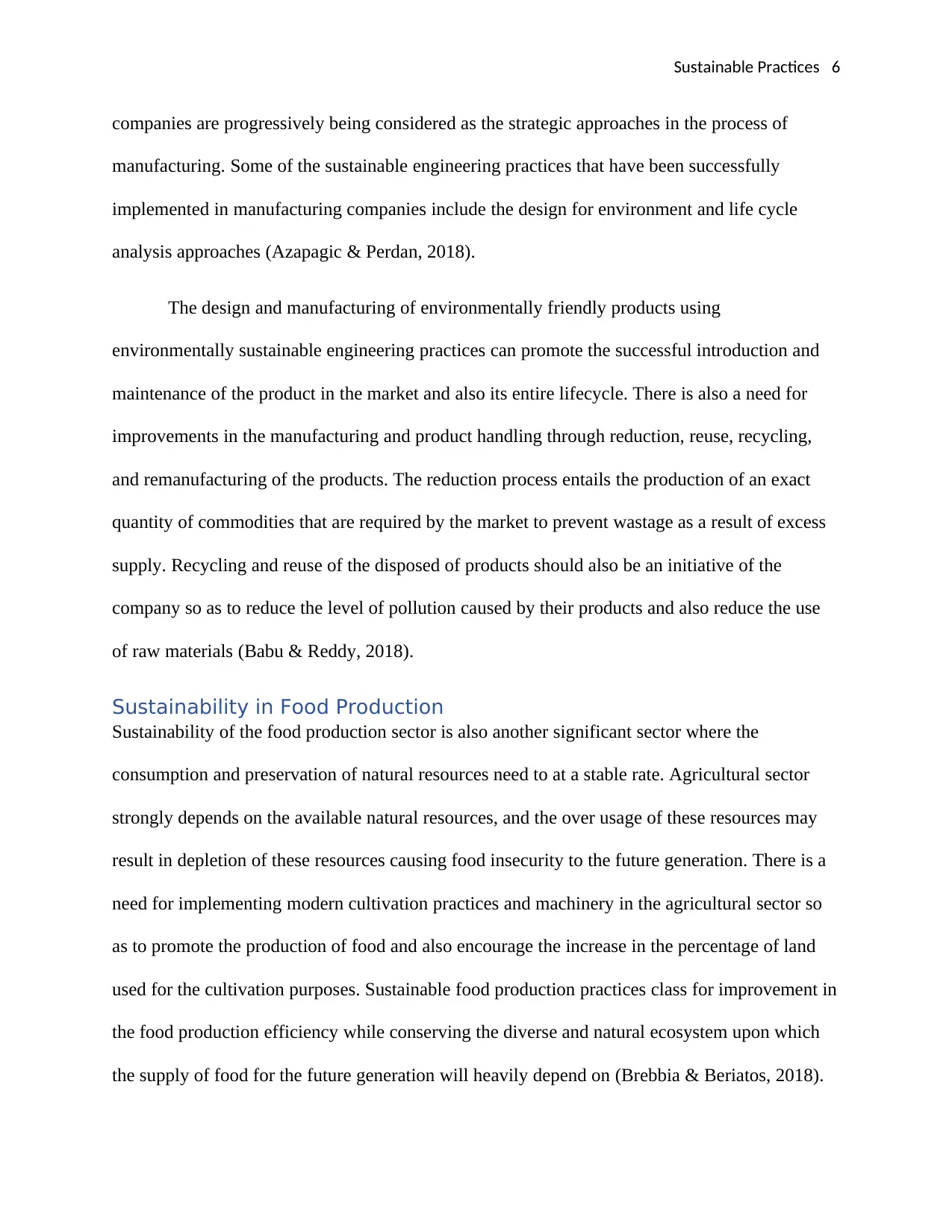
Sustainable Practices 6
companies are progressively being considered as the strategic approaches in the process of
manufacturing. Some of the sustainable engineering practices that have been successfully
implemented in manufacturing companies include the design for environment and life cycle
analysis approaches (Azapagic & Perdan, 2018).
The design and manufacturing of environmentally friendly products using
environmentally sustainable engineering practices can promote the successful introduction and
maintenance of the product in the market and also its entire lifecycle. There is also a need for
improvements in the manufacturing and product handling through reduction, reuse, recycling,
and remanufacturing of the products. The reduction process entails the production of an exact
quantity of commodities that are required by the market to prevent wastage as a result of excess
supply. Recycling and reuse of the disposed of products should also be an initiative of the
company so as to reduce the level of pollution caused by their products and also reduce the use
of raw materials (Babu & Reddy, 2018).
Sustainability in Food Production
Sustainability of the food production sector is also another significant sector where the
consumption and preservation of natural resources need to at a stable rate. Agricultural sector
strongly depends on the available natural resources, and the over usage of these resources may
result in depletion of these resources causing food insecurity to the future generation. There is a
need for implementing modern cultivation practices and machinery in the agricultural sector so
as to promote the production of food and also encourage the increase in the percentage of land
used for the cultivation purposes. Sustainable food production practices class for improvement in
the food production efficiency while conserving the diverse and natural ecosystem upon which
the supply of food for the future generation will heavily depend on (Brebbia & Beriatos, 2018).
companies are progressively being considered as the strategic approaches in the process of
manufacturing. Some of the sustainable engineering practices that have been successfully
implemented in manufacturing companies include the design for environment and life cycle
analysis approaches (Azapagic & Perdan, 2018).
The design and manufacturing of environmentally friendly products using
environmentally sustainable engineering practices can promote the successful introduction and
maintenance of the product in the market and also its entire lifecycle. There is also a need for
improvements in the manufacturing and product handling through reduction, reuse, recycling,
and remanufacturing of the products. The reduction process entails the production of an exact
quantity of commodities that are required by the market to prevent wastage as a result of excess
supply. Recycling and reuse of the disposed of products should also be an initiative of the
company so as to reduce the level of pollution caused by their products and also reduce the use
of raw materials (Babu & Reddy, 2018).
Sustainability in Food Production
Sustainability of the food production sector is also another significant sector where the
consumption and preservation of natural resources need to at a stable rate. Agricultural sector
strongly depends on the available natural resources, and the over usage of these resources may
result in depletion of these resources causing food insecurity to the future generation. There is a
need for implementing modern cultivation practices and machinery in the agricultural sector so
as to promote the production of food and also encourage the increase in the percentage of land
used for the cultivation purposes. Sustainable food production practices class for improvement in
the food production efficiency while conserving the diverse and natural ecosystem upon which
the supply of food for the future generation will heavily depend on (Brebbia & Beriatos, 2018).
⊘ This is a preview!⊘
Do you want full access?
Subscribe today to unlock all pages.

Trusted by 1+ million students worldwide
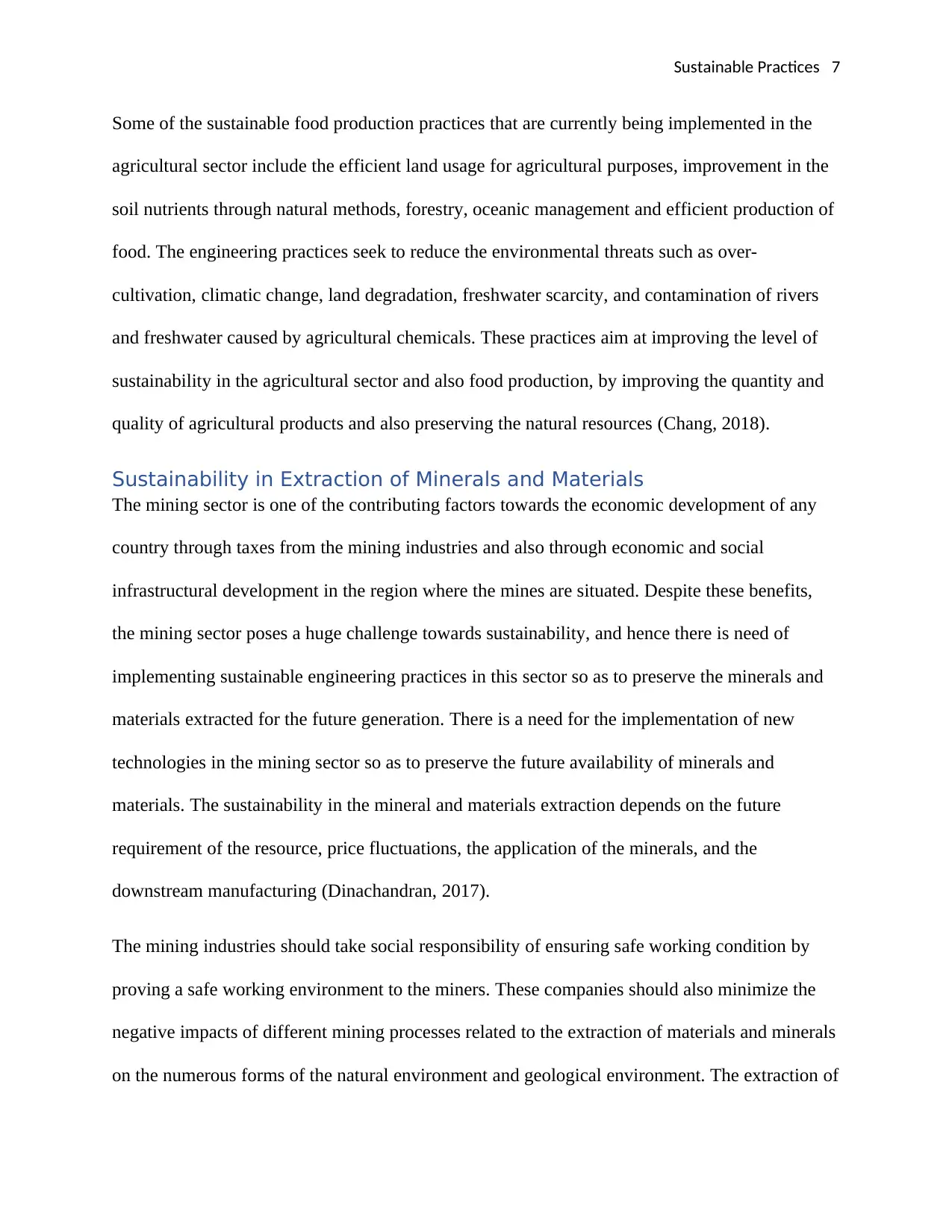
Sustainable Practices 7
Some of the sustainable food production practices that are currently being implemented in the
agricultural sector include the efficient land usage for agricultural purposes, improvement in the
soil nutrients through natural methods, forestry, oceanic management and efficient production of
food. The engineering practices seek to reduce the environmental threats such as over-
cultivation, climatic change, land degradation, freshwater scarcity, and contamination of rivers
and freshwater caused by agricultural chemicals. These practices aim at improving the level of
sustainability in the agricultural sector and also food production, by improving the quantity and
quality of agricultural products and also preserving the natural resources (Chang, 2018).
Sustainability in Extraction of Minerals and Materials
The mining sector is one of the contributing factors towards the economic development of any
country through taxes from the mining industries and also through economic and social
infrastructural development in the region where the mines are situated. Despite these benefits,
the mining sector poses a huge challenge towards sustainability, and hence there is need of
implementing sustainable engineering practices in this sector so as to preserve the minerals and
materials extracted for the future generation. There is a need for the implementation of new
technologies in the mining sector so as to preserve the future availability of minerals and
materials. The sustainability in the mineral and materials extraction depends on the future
requirement of the resource, price fluctuations, the application of the minerals, and the
downstream manufacturing (Dinachandran, 2017).
The mining industries should take social responsibility of ensuring safe working condition by
proving a safe working environment to the miners. These companies should also minimize the
negative impacts of different mining processes related to the extraction of materials and minerals
on the numerous forms of the natural environment and geological environment. The extraction of
Some of the sustainable food production practices that are currently being implemented in the
agricultural sector include the efficient land usage for agricultural purposes, improvement in the
soil nutrients through natural methods, forestry, oceanic management and efficient production of
food. The engineering practices seek to reduce the environmental threats such as over-
cultivation, climatic change, land degradation, freshwater scarcity, and contamination of rivers
and freshwater caused by agricultural chemicals. These practices aim at improving the level of
sustainability in the agricultural sector and also food production, by improving the quantity and
quality of agricultural products and also preserving the natural resources (Chang, 2018).
Sustainability in Extraction of Minerals and Materials
The mining sector is one of the contributing factors towards the economic development of any
country through taxes from the mining industries and also through economic and social
infrastructural development in the region where the mines are situated. Despite these benefits,
the mining sector poses a huge challenge towards sustainability, and hence there is need of
implementing sustainable engineering practices in this sector so as to preserve the minerals and
materials extracted for the future generation. There is a need for the implementation of new
technologies in the mining sector so as to preserve the future availability of minerals and
materials. The sustainability in the mineral and materials extraction depends on the future
requirement of the resource, price fluctuations, the application of the minerals, and the
downstream manufacturing (Dinachandran, 2017).
The mining industries should take social responsibility of ensuring safe working condition by
proving a safe working environment to the miners. These companies should also minimize the
negative impacts of different mining processes related to the extraction of materials and minerals
on the numerous forms of the natural environment and geological environment. The extraction of
Paraphrase This Document
Need a fresh take? Get an instant paraphrase of this document with our AI Paraphraser
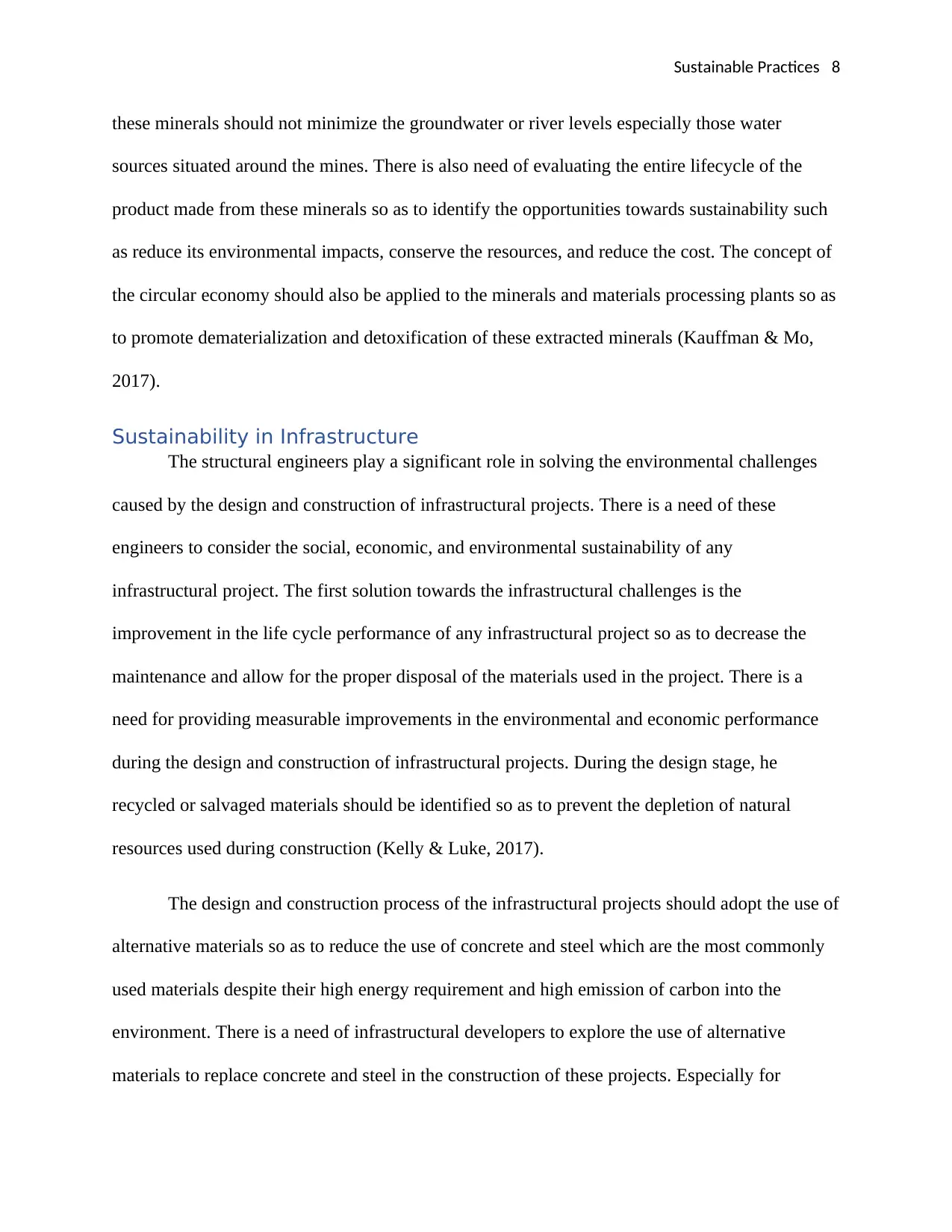
Sustainable Practices 8
these minerals should not minimize the groundwater or river levels especially those water
sources situated around the mines. There is also need of evaluating the entire lifecycle of the
product made from these minerals so as to identify the opportunities towards sustainability such
as reduce its environmental impacts, conserve the resources, and reduce the cost. The concept of
the circular economy should also be applied to the minerals and materials processing plants so as
to promote dematerialization and detoxification of these extracted minerals (Kauffman & Mo,
2017).
Sustainability in Infrastructure
The structural engineers play a significant role in solving the environmental challenges
caused by the design and construction of infrastructural projects. There is a need of these
engineers to consider the social, economic, and environmental sustainability of any
infrastructural project. The first solution towards the infrastructural challenges is the
improvement in the life cycle performance of any infrastructural project so as to decrease the
maintenance and allow for the proper disposal of the materials used in the project. There is a
need for providing measurable improvements in the environmental and economic performance
during the design and construction of infrastructural projects. During the design stage, he
recycled or salvaged materials should be identified so as to prevent the depletion of natural
resources used during construction (Kelly & Luke, 2017).
The design and construction process of the infrastructural projects should adopt the use of
alternative materials so as to reduce the use of concrete and steel which are the most commonly
used materials despite their high energy requirement and high emission of carbon into the
environment. There is a need of infrastructural developers to explore the use of alternative
materials to replace concrete and steel in the construction of these projects. Especially for
these minerals should not minimize the groundwater or river levels especially those water
sources situated around the mines. There is also need of evaluating the entire lifecycle of the
product made from these minerals so as to identify the opportunities towards sustainability such
as reduce its environmental impacts, conserve the resources, and reduce the cost. The concept of
the circular economy should also be applied to the minerals and materials processing plants so as
to promote dematerialization and detoxification of these extracted minerals (Kauffman & Mo,
2017).
Sustainability in Infrastructure
The structural engineers play a significant role in solving the environmental challenges
caused by the design and construction of infrastructural projects. There is a need of these
engineers to consider the social, economic, and environmental sustainability of any
infrastructural project. The first solution towards the infrastructural challenges is the
improvement in the life cycle performance of any infrastructural project so as to decrease the
maintenance and allow for the proper disposal of the materials used in the project. There is a
need for providing measurable improvements in the environmental and economic performance
during the design and construction of infrastructural projects. During the design stage, he
recycled or salvaged materials should be identified so as to prevent the depletion of natural
resources used during construction (Kelly & Luke, 2017).
The design and construction process of the infrastructural projects should adopt the use of
alternative materials so as to reduce the use of concrete and steel which are the most commonly
used materials despite their high energy requirement and high emission of carbon into the
environment. There is a need of infrastructural developers to explore the use of alternative
materials to replace concrete and steel in the construction of these projects. Especially for
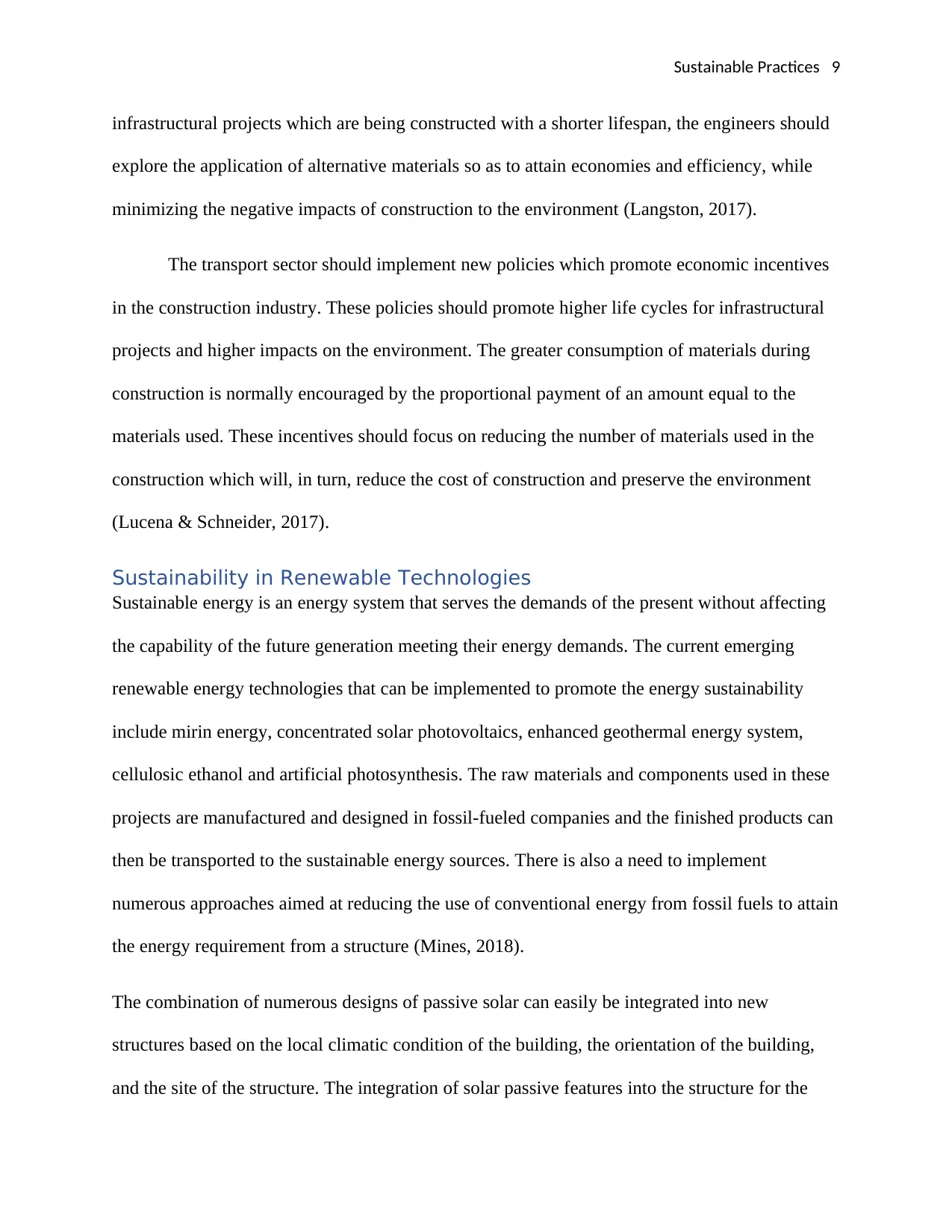
Sustainable Practices 9
infrastructural projects which are being constructed with a shorter lifespan, the engineers should
explore the application of alternative materials so as to attain economies and efficiency, while
minimizing the negative impacts of construction to the environment (Langston, 2017).
The transport sector should implement new policies which promote economic incentives
in the construction industry. These policies should promote higher life cycles for infrastructural
projects and higher impacts on the environment. The greater consumption of materials during
construction is normally encouraged by the proportional payment of an amount equal to the
materials used. These incentives should focus on reducing the number of materials used in the
construction which will, in turn, reduce the cost of construction and preserve the environment
(Lucena & Schneider, 2017).
Sustainability in Renewable Technologies
Sustainable energy is an energy system that serves the demands of the present without affecting
the capability of the future generation meeting their energy demands. The current emerging
renewable energy technologies that can be implemented to promote the energy sustainability
include mirin energy, concentrated solar photovoltaics, enhanced geothermal energy system,
cellulosic ethanol and artificial photosynthesis. The raw materials and components used in these
projects are manufactured and designed in fossil-fueled companies and the finished products can
then be transported to the sustainable energy sources. There is also a need to implement
numerous approaches aimed at reducing the use of conventional energy from fossil fuels to attain
the energy requirement from a structure (Mines, 2018).
The combination of numerous designs of passive solar can easily be integrated into new
structures based on the local climatic condition of the building, the orientation of the building,
and the site of the structure. The integration of solar passive features into the structure for the
infrastructural projects which are being constructed with a shorter lifespan, the engineers should
explore the application of alternative materials so as to attain economies and efficiency, while
minimizing the negative impacts of construction to the environment (Langston, 2017).
The transport sector should implement new policies which promote economic incentives
in the construction industry. These policies should promote higher life cycles for infrastructural
projects and higher impacts on the environment. The greater consumption of materials during
construction is normally encouraged by the proportional payment of an amount equal to the
materials used. These incentives should focus on reducing the number of materials used in the
construction which will, in turn, reduce the cost of construction and preserve the environment
(Lucena & Schneider, 2017).
Sustainability in Renewable Technologies
Sustainable energy is an energy system that serves the demands of the present without affecting
the capability of the future generation meeting their energy demands. The current emerging
renewable energy technologies that can be implemented to promote the energy sustainability
include mirin energy, concentrated solar photovoltaics, enhanced geothermal energy system,
cellulosic ethanol and artificial photosynthesis. The raw materials and components used in these
projects are manufactured and designed in fossil-fueled companies and the finished products can
then be transported to the sustainable energy sources. There is also a need to implement
numerous approaches aimed at reducing the use of conventional energy from fossil fuels to attain
the energy requirement from a structure (Mines, 2018).
The combination of numerous designs of passive solar can easily be integrated into new
structures based on the local climatic condition of the building, the orientation of the building,
and the site of the structure. The integration of solar passive features into the structure for the
⊘ This is a preview!⊘
Do you want full access?
Subscribe today to unlock all pages.

Trusted by 1+ million students worldwide
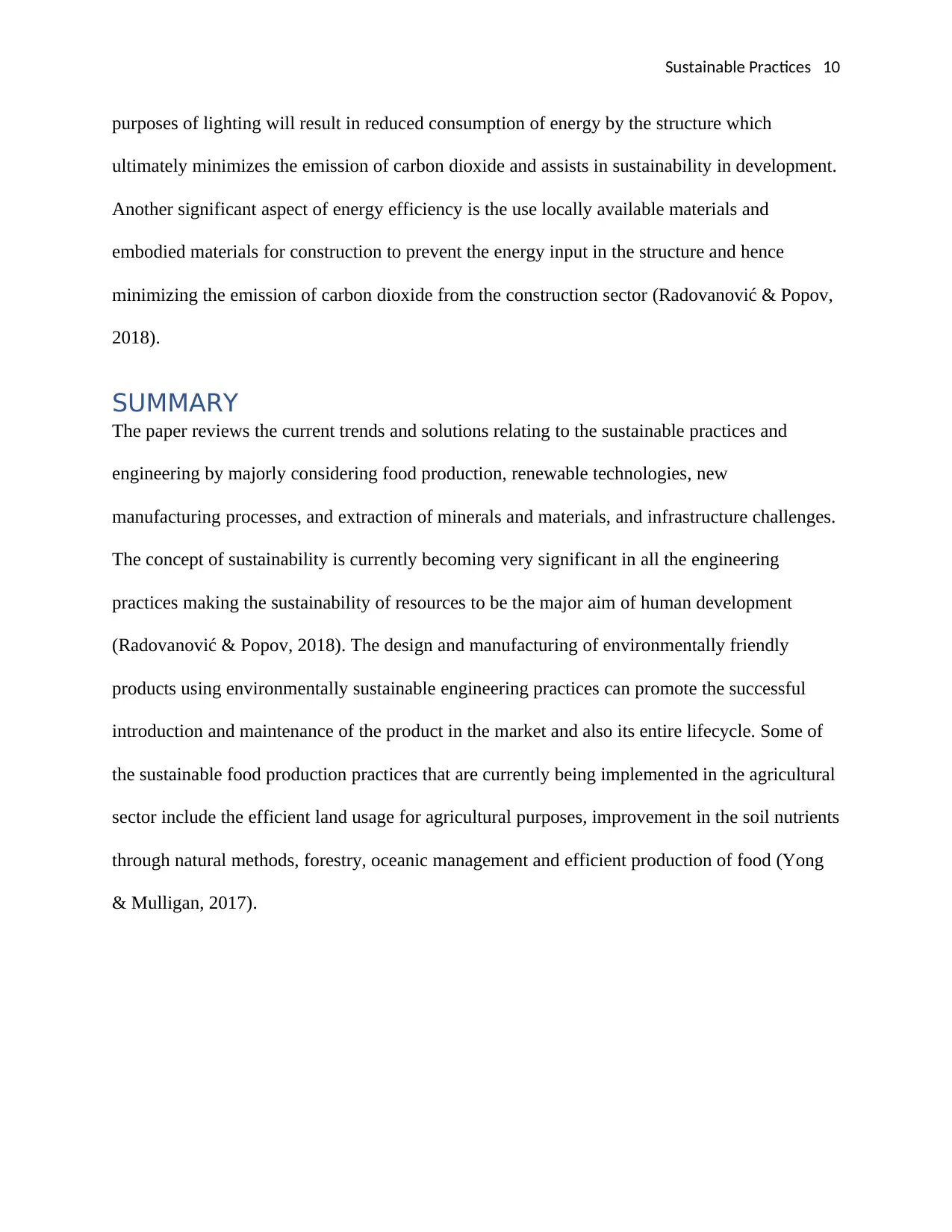
Sustainable Practices 10
purposes of lighting will result in reduced consumption of energy by the structure which
ultimately minimizes the emission of carbon dioxide and assists in sustainability in development.
Another significant aspect of energy efficiency is the use locally available materials and
embodied materials for construction to prevent the energy input in the structure and hence
minimizing the emission of carbon dioxide from the construction sector (Radovanović & Popov,
2018).
SUMMARY
The paper reviews the current trends and solutions relating to the sustainable practices and
engineering by majorly considering food production, renewable technologies, new
manufacturing processes, and extraction of minerals and materials, and infrastructure challenges.
The concept of sustainability is currently becoming very significant in all the engineering
practices making the sustainability of resources to be the major aim of human development
(Radovanović & Popov, 2018). The design and manufacturing of environmentally friendly
products using environmentally sustainable engineering practices can promote the successful
introduction and maintenance of the product in the market and also its entire lifecycle. Some of
the sustainable food production practices that are currently being implemented in the agricultural
sector include the efficient land usage for agricultural purposes, improvement in the soil nutrients
through natural methods, forestry, oceanic management and efficient production of food (Yong
& Mulligan, 2017).
purposes of lighting will result in reduced consumption of energy by the structure which
ultimately minimizes the emission of carbon dioxide and assists in sustainability in development.
Another significant aspect of energy efficiency is the use locally available materials and
embodied materials for construction to prevent the energy input in the structure and hence
minimizing the emission of carbon dioxide from the construction sector (Radovanović & Popov,
2018).
SUMMARY
The paper reviews the current trends and solutions relating to the sustainable practices and
engineering by majorly considering food production, renewable technologies, new
manufacturing processes, and extraction of minerals and materials, and infrastructure challenges.
The concept of sustainability is currently becoming very significant in all the engineering
practices making the sustainability of resources to be the major aim of human development
(Radovanović & Popov, 2018). The design and manufacturing of environmentally friendly
products using environmentally sustainable engineering practices can promote the successful
introduction and maintenance of the product in the market and also its entire lifecycle. Some of
the sustainable food production practices that are currently being implemented in the agricultural
sector include the efficient land usage for agricultural purposes, improvement in the soil nutrients
through natural methods, forestry, oceanic management and efficient production of food (Yong
& Mulligan, 2017).
Paraphrase This Document
Need a fresh take? Get an instant paraphrase of this document with our AI Paraphraser
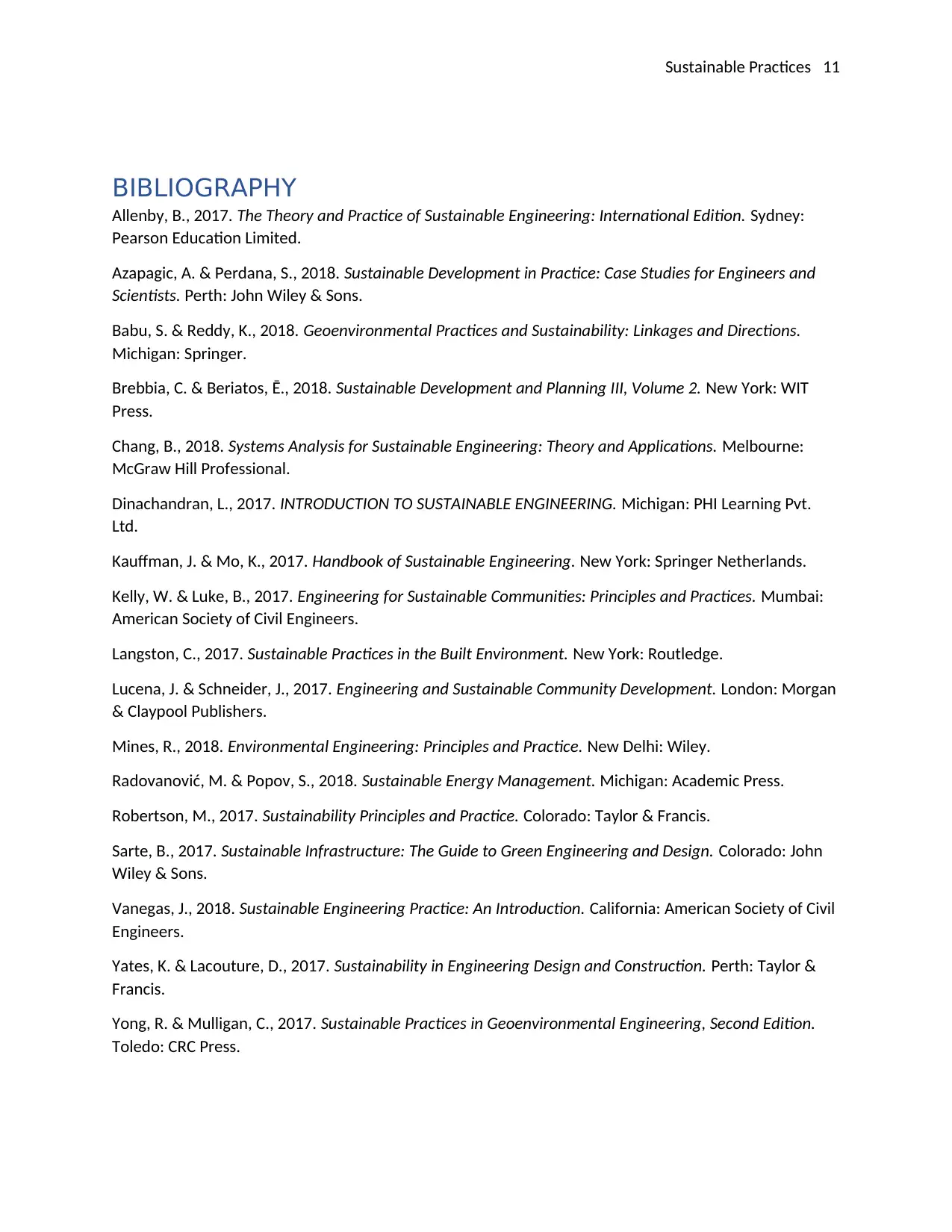
Sustainable Practices 11
BIBLIOGRAPHY
Allenby, B., 2017. The Theory and Practice of Sustainable Engineering: International Edition. Sydney:
Pearson Education Limited.
Azapagic, A. & Perdana, S., 2018. Sustainable Development in Practice: Case Studies for Engineers and
Scientists. Perth: John Wiley & Sons.
Babu, S. & Reddy, K., 2018. Geoenvironmental Practices and Sustainability: Linkages and Directions.
Michigan: Springer.
Brebbia, C. & Beriatos, Ē., 2018. Sustainable Development and Planning III, Volume 2. New York: WIT
Press.
Chang, B., 2018. Systems Analysis for Sustainable Engineering: Theory and Applications. Melbourne:
McGraw Hill Professional.
Dinachandran, L., 2017. INTRODUCTION TO SUSTAINABLE ENGINEERING. Michigan: PHI Learning Pvt.
Ltd.
Kauffman, J. & Mo, K., 2017. Handbook of Sustainable Engineering. New York: Springer Netherlands.
Kelly, W. & Luke, B., 2017. Engineering for Sustainable Communities: Principles and Practices. Mumbai:
American Society of Civil Engineers.
Langston, C., 2017. Sustainable Practices in the Built Environment. New York: Routledge.
Lucena, J. & Schneider, J., 2017. Engineering and Sustainable Community Development. London: Morgan
& Claypool Publishers.
Mines, R., 2018. Environmental Engineering: Principles and Practice. New Delhi: Wiley.
Radovanović, M. & Popov, S., 2018. Sustainable Energy Management. Michigan: Academic Press.
Robertson, M., 2017. Sustainability Principles and Practice. Colorado: Taylor & Francis.
Sarte, B., 2017. Sustainable Infrastructure: The Guide to Green Engineering and Design. Colorado: John
Wiley & Sons.
Vanegas, J., 2018. Sustainable Engineering Practice: An Introduction. California: American Society of Civil
Engineers.
Yates, K. & Lacouture, D., 2017. Sustainability in Engineering Design and Construction. Perth: Taylor &
Francis.
Yong, R. & Mulligan, C., 2017. Sustainable Practices in Geoenvironmental Engineering, Second Edition.
Toledo: CRC Press.
BIBLIOGRAPHY
Allenby, B., 2017. The Theory and Practice of Sustainable Engineering: International Edition. Sydney:
Pearson Education Limited.
Azapagic, A. & Perdana, S., 2018. Sustainable Development in Practice: Case Studies for Engineers and
Scientists. Perth: John Wiley & Sons.
Babu, S. & Reddy, K., 2018. Geoenvironmental Practices and Sustainability: Linkages and Directions.
Michigan: Springer.
Brebbia, C. & Beriatos, Ē., 2018. Sustainable Development and Planning III, Volume 2. New York: WIT
Press.
Chang, B., 2018. Systems Analysis for Sustainable Engineering: Theory and Applications. Melbourne:
McGraw Hill Professional.
Dinachandran, L., 2017. INTRODUCTION TO SUSTAINABLE ENGINEERING. Michigan: PHI Learning Pvt.
Ltd.
Kauffman, J. & Mo, K., 2017. Handbook of Sustainable Engineering. New York: Springer Netherlands.
Kelly, W. & Luke, B., 2017. Engineering for Sustainable Communities: Principles and Practices. Mumbai:
American Society of Civil Engineers.
Langston, C., 2017. Sustainable Practices in the Built Environment. New York: Routledge.
Lucena, J. & Schneider, J., 2017. Engineering and Sustainable Community Development. London: Morgan
& Claypool Publishers.
Mines, R., 2018. Environmental Engineering: Principles and Practice. New Delhi: Wiley.
Radovanović, M. & Popov, S., 2018. Sustainable Energy Management. Michigan: Academic Press.
Robertson, M., 2017. Sustainability Principles and Practice. Colorado: Taylor & Francis.
Sarte, B., 2017. Sustainable Infrastructure: The Guide to Green Engineering and Design. Colorado: John
Wiley & Sons.
Vanegas, J., 2018. Sustainable Engineering Practice: An Introduction. California: American Society of Civil
Engineers.
Yates, K. & Lacouture, D., 2017. Sustainability in Engineering Design and Construction. Perth: Taylor &
Francis.
Yong, R. & Mulligan, C., 2017. Sustainable Practices in Geoenvironmental Engineering, Second Edition.
Toledo: CRC Press.
1 out of 11
Related Documents
Your All-in-One AI-Powered Toolkit for Academic Success.
+13062052269
info@desklib.com
Available 24*7 on WhatsApp / Email
![[object Object]](/_next/static/media/star-bottom.7253800d.svg)
Unlock your academic potential
Copyright © 2020–2025 A2Z Services. All Rights Reserved. Developed and managed by ZUCOL.




